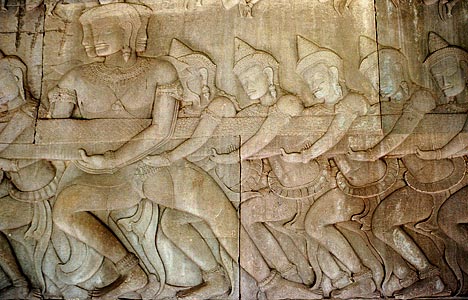Angkor Wat Temple : Interesting Facts and Mystery | Cambodia

In the heart of Cambodia, buried for centuries in the forest, there is an ancient and wonderful secret carved in stone.
Angkor Wat temple
Angkor, Cambodia, is an awe-inspiring place shrouded in mystery. An ancient city, considered today as one of the great wonders of our planet. Angkor Wat is the most famous temple, and its name comes from old Sanskrit which, contracted in the Khmer language, means "temple of the capital". It is a magical place, with fascinating architecture: it is no accident that it has become the main attraction of Cambodia and that it is featured on the national flag of this Asian country. But there are still many unresolved mysteries inside. The walls of the sacred Angkor temples contain, in fact, a very ancient story: their stones and bas-reliefs tell an incredible legend, suspended between the sky, the stars and the prophecies.
Interesting mathematical facts
Seen from above, all of Angkor Wat looks like a map. Its main building is an equinoctial structure, that is, it is oriented along the east-west axis and is arranged so that, at the spring equinox, the sun rises on the central tower. Then, the number 72 plays an important role: it seems that the old builders wanted to highlight this number in the architectural complex. Perhaps this is just a coincidence, but there are 72 architectural structures in Angkor Wat; 72 corresponds to the number of degrees of longitude which separate it from the legendary pyramid of Cheops, to the west, and 144 (72 x 2) to the number of degrees which separate it from the moai of Easter Island, to the East.
And nothing at Angkor Wat seems to be a fluke. Just think that there are four eras in Hindu mythology - the Krita Yuga (which lasts 1,728,000 years), the Treta Yuga (1,296,000 years), then the Davpara (864,000 years) and finally the Kali Yuga (432,000 years) - and sections at Angkor show exactly those same values if measured in hat, a local unit of measurement. Those who built this architectural gem knew very precisely what the numbers should represent in this place.
Astrological theories and Angkor Wat bas relief

If we had to think of a link between the great mythical places of our planet, this one could be represented by the stars. This fantastic hypothesis has given rise to the most incredible theories: the Angkor buildings project, for example, would appear to reproduce the constellation of the Dragon just as the pyramids of Giza appear to reproduce the Orion’s Belt. However, the Dragon was visible during the spring equinox at Angkor latitudes for the last time in 10,500 BC ; and, on the same date, the Sphinx of Giza would have looked on the horizon at the constellation Leo, which some say he represents. This is precisely a fanciful theory that would overturn everything we know about the history of ancient civilizations on our planet. 12,000 years ago - as far as we know - there were no civilizations developed to the point of producing works of such grandeur and complexity. Official archeology establishes, however, that the construction of the Angkor Wat temple took place between 1113 and 1150, by order of King Suryavarman II.
But among the 1,200 square meters of spectacular and detailed bas-reliefs that adorn the constructions of Angkor Wat, there is an interesting clue, carved in stone, the legend of a part of Hindu mythology known through the expression, the “churning of the sea of milk”. For some, this would be a metaphor describing a precise scientific theory: the precession of the equinoxes, a fundamental astronomical phenomenon for those who observe the heavens. On the bas-relief, the Asura (the gods) and the Deva (the angels) draw the rings of the Serpent - which would represent the constellation of the Dragon - wrapped around Mount Mandara to facilitate the passage from one astrological era to another. And thus explain why the sky we observe changes slowly over the centuries. A final curiosity: in the temple of Ta Prohm - one of the few that has not been restored - another curious engraving fires the imagination of tourists; this is the "dinosaur bas-relief". An animal figure very close to the prehistoric Stegosaurus. A creature that, however, died out 140 million years ago, at a time when humans did not yet inhabit this planet.









































































































































































































































































































































